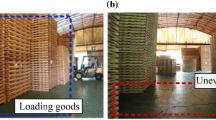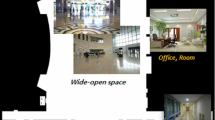Abstract
This paper proposes a robust localization system using complementary information extracted from ceiling and ground plans, particularly applicable to dynamic and complex environments. The ceiling perception provides the robot with stable and time-invariant environmental features independent of the dynamic changes on the ground, whereas the ground perception allows the robot to navigate in the ground plane while avoiding stationary obstacles. We propose an architecture to fuse ground 2D LiDAR scan and ceiling 3D LiDAR scan with our enhanced mapping algorithm associating perception from both sources efficiently. The localization ability and the navigation performance can be promisingly secured even in a harsh environment with our complementary sensed information from the ground and ceiling. The salient feature of our work is that our system can simultaneously map both the ceiling and ground plane efficiently without extra efforts of deploying articulated landmarks and apply such hybrid information effectively, which facilitates the robot to travel through any indoor environment with human crowds without getting lost.















Similar content being viewed by others
References
Bahraini, M. S., Bozorg, M., & Rad, A. B. (2018). SLAM in dynamic environments via ML-RANSAC. Mechatronics, 49, 105–118.
Besl, P. J., & McKay, N. D. (1992). Method for registration of 3-D shapes. In P. S. Schenker (Ed.), Sensor fusion IV: Control paradigms and data structures (Vol. 1611, pp. 586–606). https://doi.org/10.1117/12.57955
Biber, P., & Straßer, W. (2003). The normal distributions transform: A new approach to laser scan matching. In Proceedings 2003 IEEE/RSJ International Conference on Intelligent Robots and Systems (IROS 2003)(cat. no. 03ch37453) (Vol. 3, pp. 2743–2748).
Fukuda, T., Ito, S., Oota, N., Arai, F., Abe, Y., Tanaka, K., & Tanaka, Y. (1993). Navigation system based on ceiling landmark recognition for autonomous mobile robot. In Proceedings of IECON’93-19th Annual Conference of IEEE Industrial Electronics (pp. 1466–1471).
Hackel, T., Wegner, J. D., & Schindler, K. (2016). Contour detection in unstructured 3D point clouds. In Proceedings of the IEEE Conference on Computer Vision and Pattern Recognition (pp. 1610–1618).
Hong, H., & Lee, B. H. (2017). Probabilistic normal distributions transform representation for accurate 3D point cloud registration. In 2017 IEEE/RSJ International Conference on Intelligent Robots and Systems (IROS) (pp. 3333–3338).
Hwang, S. Y., & Song, J. B. (2011). Monocular vision-based SLAM in indoor environment using corner, lamp, and door features from upward-looking camera. IEEE Transactions on Industrial Electronics, 58(10), 4804–4812.
Jeong, W., & Lee, K. M. (2005). CV-SLAM: A new ceiling vision-based SLAM technique. In 2005 IEEE/RSJ International Conference on Intelligent Robots and Systems (pp. 3195–3200).
Lecking, D., Wulf, O., Wagner, B. (2008). Localization in a wide range of industrial environments using relative 3D ceiling features. In 2008 IEEE International Conference on Emerging Technologies and Factory Automation (pp. 333–337).
Lee, J. S., Lim, Y. C., & Ryoo, Y. J. (2005). Vision-based self localization using ceiling artificial landmark for ubiquitous mobile robot. Journal of the Korean Institute of Intelligent Systems, 15(5), 560–566.
Li, R., Liu, Q., Gui, J., Gu, D., & Hu, H. (2017). Indoor relocalization in challenging environments with dual-stream convolutional neural networks. IEEE Transactions on Automation Science and Engineering, 15(2), 651–662.
Magnusson, M. (2009). The three-dimensional normal-distributions transform: An efficient representation for registration, surface analysis, and loop detection. Örebro universitet.
Mahalanobis, P. C. (2018). On the generalized distance in statistics. Sankhyā: The Indian Journal of Statistics, Series A (2008), 80, S1–S7.
Pauly, M., Keiser, R., & Gross, M. (2003). Multi-scale feature extraction on point-sampled surfaces. In Computer Graphics Forum (Vol. 22, pp. 281–289).
Reinhardt, M., Noack, B., & Hanebeck, U. D. (2012). Closed-form optimization of covariance intersection for low-dimensional matrices. In 2012 15th International Conference on Information Fusion (pp. 1891–1896).
Rusdinar, A., Kim, J., Lee, J., & Kim, S. (2012). Implementation of real-time positioning system using extended Kalman filter and artificial landmark on ceiling. Journal of Mechanical Science and Technology, 26(3), 949–958.
Rusu, R. B., & Cousins, S. (2011). 3d is here: Point cloud library (PCL). In 2011 IEEE International Conference on Robotics and Automation (pp. 1–4).
Valencia, R., Saarinen, J., Andreasson, H., Vallvé, J., Andrade-Cetto, J., & Lilienthal, A. J. (2014). Localization in highly dynamic environments using dual-timescale NDT-MCL. In 2014 IEEE International Conference on Robotics and Automation (ICRA) (pp. 3956-3962). https://doi.org/10.1109/ICRA.2014.6907433
Vidal, J., & Lin, C. Y. (2016). Simple and robust localization system using ceiling landmarks and infrared light. In 2016 12th IEEE International Conference on Control and Automation (ICCA) (pp. 583–587).
Weinmann, M., Jutzi, B., & Mallet, C. (2013). Feature relevance assessment for the semantic interpretation of 3D point cloud data. ISPRS Annals of Photogrammetry, Remote Sensing and Spatial Information Sciences, Nov 2013, Antalya, Turkey (pp. 313–318). https://doi.org/10.5194/isprsannals-II-5-W2-313-2013
Wulf, O., Lecking, D., & Wagner, B. (2006). Robust self-localization in industrial environments based on 3D ceiling structures. In 2006 IEEE/RSJ International Conference on Intelligent Robots and Systems (pp. 1530–1534).
Acknowledgements
The authors are deeply grateful to Zu Lin Ewe for his assistance with the additional experiments suggested by the reviewer. His contribution was instrumental in enhancing the quality and scope of this research.
Funding
This research was supported by the National Science and Technology Council of the Republic of China, and Center for Artificial Intelligence & Advanced Robotics, National Taiwan University, under the grant number MOST 111-2634-F-002-021 and MOST 111-2223-E-002-008.
Author information
Authors and Affiliations
Corresponding author
Ethics declarations
Conflict of interest
The authors have no relevant financial or non-financial interests to disclose.
Additional information
Publisher's Note
Springer Nature remains neutral with regard to jurisdictional claims in published maps and institutional affiliations.
Rights and permissions
Springer Nature or its licensor (e.g. a society or other partner) holds exclusive rights to this article under a publishing agreement with the author(s) or other rightsholder(s); author self-archiving of the accepted manuscript version of this article is solely governed by the terms of such publishing agreement and applicable law.
About this article
Cite this article
Yu, CA., Chen, HY., Wang, CC. et al. Complex environment localization system using complementary ceiling and ground map information. Auton Robot 47, 669–683 (2023). https://doi.org/10.1007/s10514-023-10116-6
Received:
Accepted:
Published:
Issue Date:
DOI: https://doi.org/10.1007/s10514-023-10116-6




